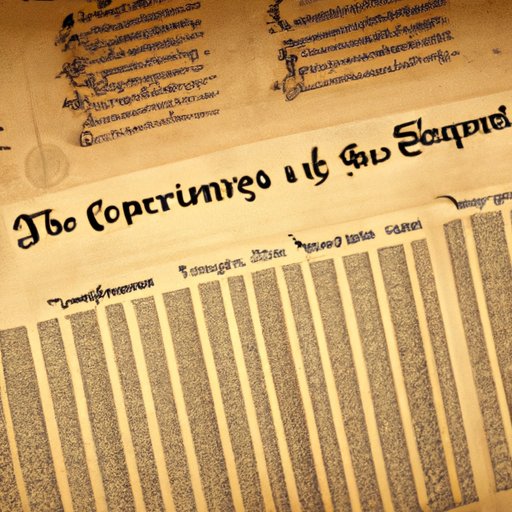How Many People Signed The Constitution?
When the United States Constitution was created in 1787, it was the first of its kind for a new nation. Its signers were responsible for forming the backbone of the country’s structure, and the document itself would act as the foundation for all future laws and government operations thereof. Understanding how many people signed the Constitution is an important part of understanding its historical significance.
A Historical Account
The Continental Congress authorized the convention that eventually led to the drafting of the Constitution in May 1787. The location of the convention was in Independence Hall in Philadelphia, Pennsylvania. Delegates arrived shortly thereafter, with the last group arriving in late July. The first order of business was electing a presiding officer to oversee the convention and ensure it was run fairly. This honor went to George Washington, who had helped win the Revolutionary War by leading the Continental Army.
Throughout the convention, attendees discussed and debated the language and construction of the Constitution. The goal of the framers was to create a document that would be acceptable to all delegates and that would serve as the fundamental law of the land. Many revisions and amendments were proposed and discussed in the hopes of crafting the perfect document. By the end of the convention roughly four months later, 39 delegates had signed the Constitution.
Constitutional Statistics
The number of delegates that attended the Constitutional Convention was 55, but only 39 of these delegates affixed their signatures to the final document. The signers represented 12 out of the original 13 states; Rhode Island did not have a representative present at the convention. The comparison between this small number and the overall population of the United States is staggering; at the time of the Convention, the population of the United States was at around 4 million. It is important to remember, of course, that women, African Americans (whether free or slaves), and Native Americans had no participating voice in the Convention, only the white, male land-owning representatives of the 12 states that sent delegates.
As for the signers themselves, they were a diverse group. They ranged in age from 26 (Jonathan Dayton) to 81 (Benjamin Franklin) and hailed from various occupations and walks of life. One-third of the signers were lawyers and nearly half of them were plantation owners. They came from every state represented, showing the need for a unified and stable government throughout the newly formed nation.
The Contribution of Each Signer
Every signer left their mark on the Constitution in some way or another, whether through writing, editing, debating, or otherwise participating in the drafting process. Some were the driving forces behind major ideas that would directly shape the eventual document, while others provided equally important support and creative cooperation. Key signers include James Madison, John Adams, Alexander Hamilton, Benjamin Franklin, and George Washington. Their contributions included specific language such as the “necessary and proper” clause, which has been used to justify an array of federal powers in the modern day.
Additionally, the beliefs and values that each signer held helped create the diverse and balanced document we recognize today. Some favored strong federal power, while others called for a greater emphasis on state power, still, others advocated for a balance between the two camps. All of these positions came together to create a cohesive document that will continue to serve as the foundation of the United States government.
A Controversial Process
While the final document of the Constitution was celebrated as a great achievement in American history, the process of drafting it was not without difficulties. Representatives often found themselves at odds, sometimes bitterly, over key issues like state representation and federal power. The Franklin compromise was born from the intense tension created by these debates, offering a resolution on representation and other important issues, and making a final document possible.
This process of drafting was also controversial because of disagreements and differences, including the eventual split between the Federalists and Anti-Federalists. The anti-federalists were vehemently opposed to the Constitution and the potential changes it posed to the current system. However, in the end, a compromise was reached and the Constitution was signed by the majority of the delegates.
Understanding the Signing Ceremony
On September 17, 1787, the signers of the Constitution gathered at Independence Hall in Philadelphia to formally sign the document. The atmosphere of the occasion was solemn and serious, with the weight of the moment not being lost on those present.
As the ceremony began, each participant stepped forward to sign their name on the document, etching their place in history. Although the signing ceremony was not nearly as dramatic, or as climactic, as it has been portrayed in popular culture, being in the presence of the historic document, at the time, was an event that left a lasting impact upon the signers and the nation as a whole. The Constitution is a symbol of freedom, democracy, and the struggle for independence.
Conclusion
The signing of the Constitution was a truly historic moment. While only a small number of delegates actually signed the document, their impact on American history cannot be over-stated. The Constitution is considered one of the most important documents in history, laying the foundation for the United States democracy and government, and remains an inspiration to others struggling for individual liberties and emancipation throughout the world.
Understanding how many people actually signed the Constitution only scratches the surface of the document’s significance. The ideals and beliefs that the signers left behind will continue to shape American society and have an impact upon the globe for generations to come.
